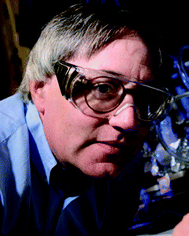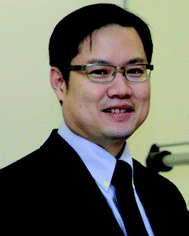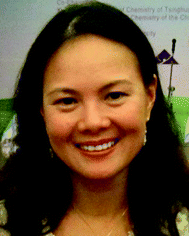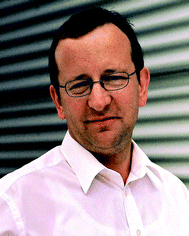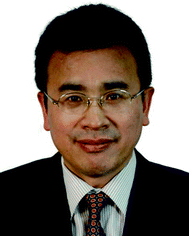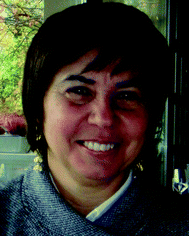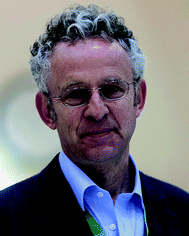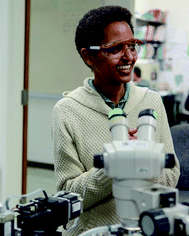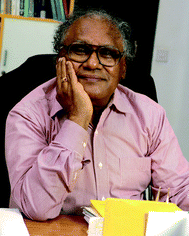DOI:
10.1039/C3MH90002A
(Editorial)
Mater. Horiz., 2014,
1, 12-16
Meet the editorial board
Professor Seth R. Marder, Chair
Seth R. Marder obtained his Ph.D. from the University of Wisconsin–Madison in 1985. After postdoctoral research at the University of Oxford, and a National Research Council Resident Research Assoc. at the Jet Propulsion Laboratory (JPL), California Institute of Technology (Caltech), he became a member of the Technical Staff at the JPL. In 1998, he moved to the University of Arizona where he was a Professor of Chemistry and Optical Sciences. In 2003, he joined the Georgia Institute of Technology where he is currently a Regents' Professor of Chemistry and a Professor of Materials Science and Engineering (courtesy). He was appointed Georgia Power Chair in Energy Efficiency in January 2010.
Dr Marder was a founding director of the Center for Organic Photonics and Electronics and is the Co-Director of the NSF Materials Research Science and Engineering Center (MRSEC) at Georgia Tech. He is a recipient of the American Chemical Society (ACS) Arthur C. Cope Scholar Award, and Fellow of the Optical Society of America, Society of Photo-optical Instrumentation Engineers (SPIE), American Physical Society, Royal Society of Chemistry, and the American Association for the Advancement of Science. His research interests are in the development of materials for nonlinear optics, applications of organic dyes for photonic, display, electronic and medical applications, and organometallic chemistry.
Professor Kian Ping Loh, Scientific Editor
Professor Kian Ping Loh did his Bachelor degree in Chemistry at the National University of Singapore, obtained his D. Phil. from the University of Oxford in 1996 and worked in the National Institute for Materials Science, Tsukuba, Japan between 1997 and 1998. He has an established track record in functional carbon materials research, focusing on the surface chemistry, biosensing, solar and optical applications of diamond and graphene. The expertise of his group ranges from the surface science of carbon in the atomic domains, optical studies of advanced functional carbon materials, design and synthesis of organic dyes, and molecular electronics to solar cells and surface science. He also works on the industrial scaling and applications of graphene composites.
He is a founding member of the Graphene Research Centre at NUS and is currently Head of the Chemistry Department, NUS. He is also working actively on two dimensional thin film and optoelectronics research at NUS.
Recent research accomplishments of his include pioneering a controllable pathway to generate geometrically well-defined graphene quantum dots and strained graphene nanostructures which boost graphene's promise as a next-generation semiconductor, inventing an ultra-slim broadband polariser that uses graphene to convert light into polarised light, a breakthrough that can broaden the bandwidth of prevailing optical fibre-based telecommunication systems, and investigating the origin of catalytic reactivity in porous graphene.
He won the Faculty Young Scientist award in 2007, NRF Competitive Research Program award, University Young Researcher award in 2008, Outstanding Chemist award in 2009, the Singapore Millennium Foundation–Research Horizon award in 2010 and the Dean's Chair Professorship in 2010.
Professor Thuc-Quyen Nguyen, Scientific Editor
Thuc-Quyen Nguyen is a professor at the Center for Polymers and Organic Solids and Chemistry & Biochemistry Department at the University of California, Santa Barbara (UCSB). She received her Ph.D. degree in physical chemistry from the University of California, Los Angeles in 2001 under the supervision of Professor Benjamin Schwartz. Her thesis focused on photophysics of conducting polymers using ultrafast spectroscopy. From 2001 to 2004, she was a research associate in the Department of Chemistry and the Nanocenter at Columbia University working with Professors Louis Brus and Colin Nuckolls on molecular self-assembly, nanoscale characterization, and molecular electronics. She also spent time at the IBM Research Center at T. J. Watson working with Richard Martel and Phaedon Avouris. In 2004, she started an assistant professorship at UCSB and was promoted to full professor in 2011. Her current research interests are structure–function–property relationships in organic semiconductors, electronic properties of conjugated polyelectrolytes, interfaces in optoelectronic devices, charge transport in organic semiconductors and across membranes, device physics, and nanoscale characterization of organic solar cells. Her group has published over 120 peer reviewed papers. Recognition for her research includes the 2005 Office of Naval Research Young Investigator Award, the 2006 National Science Foundation CAREER Award, the 2007 Harold Plous Award (one of the UCSB's two most prestigious faculty honors), the 2008 Camille Dreyfus Teacher Scholar Award, the 2009 Alfred Sloan Research Fellowship, and the 2010 National Science Foundation American Competitiveness and Innovation Fellowship.
Professor Markus Antonietti, Editorial Board member
Markus Antonietti is the Director for Colloid Chemistry at the Max Planck Institute of Colloids and Interfaces and a Professor at the University of Potsdam.
He is the author of around 520 research papers and has received widespread recognition for his work in polymer chemistry. His awards include the Gerhard-Hess prize of the German Science Foundation (1990), the Goldschmidt-Elhuyar-Award of the Real Sociedad Espanola de Quimica (2003) and the Grignard-Wittig Award of the French Chemical Society (2011). In 2009, he was awarded the Gold Medal of the Macro Group UK for lifetime achievement.
Professor Antonietti is a member of the Berlin Brandenburgische Akademie der Wissenschaften and a Fellow of the Royal Society of Chemistry. He has received honorary degrees from Clarkson University in New York and the University of Stockholm. In 2011, he spent time as a Guest Professor at Zheijand University, Fuzhou University and the University of Science and Technology of China.
Professor Antonietti's research interests are varied, extending from polymers, through porous materials, to biomimetic principles in material science. His current focus lies in questions of sustainability and the rediscovery of “simplicity” in science.
Professor Yoshio Bando, Editorial Board member
Yoshio Bando received a Ph.D. degree at Osaka University in 1975 and joined the National Institute for Research in Inorganic Materials (at present the National Institute for Materials Science, NIMS) in the same year. He is now a Fellow of NIMS and a Chief Operating Officer (COO) of the International Center for Materials Nanoarchitectonics (WPI-MANA). From 1979 to 1981, he has been a visiting scientist at the Arizona State University, USA. He served as Professor of Tsukuba University from 1992 to 2008. He has been Adjunct Professor at Waseda University since 2008. He has received a number of awards including the 3rd Thomson Reuters Research Front Award (2012), the 16th Tsukuba Prize (2005), Academic Awards from the Japanese Ceramic Society (1997) and the Seto Award from the Japanese Society for Electron Microscopy (1994). He is now an adjunct member of the Science Council of Japan and also a Fellow of the American Ceramic Society. He served as Editor-in-chief of the Journal of Electron Microscopy from 2008–2012. He has been selected as an ISI Highly Cited Researcher in Materials Science. His current research concentrates on the synthesis and properties of novel inorganic 1D/2D nanomaterials and their
in situ TEM analysis. His and his group’s research works “Discovery of nanothermometer”, “Development of high purity synthesis of BN nanotubes”, and “Creation of various kinds of novel inorganic nanotubes/nanowires” were internationally accepted.
Professor Jun Chen, Editorial Board member
Jun Chen is the Chair Professor of energy materials chemistry at Nankai University, the Director of the Key Laboratory of Advanced Energy Materials Chemistry (Ministry of Education), a Chief Scientist of National Nano Key Science Research, and the Vice Chairman of the Chinese Society of Electrochemistry. He received his B.S. and M.S. degrees from Nankai University in 1989 and 1992, respectively, and his Ph.D. from Wollongong University (Australia) in 1999. He held the NEDO fellowship at the National Institute of AIST Kansai Center (Japan) from 1999 to 2002. His research activity focuses on nanomaterials, electrochemistry, batteries, fuel cells and solar cells with efficient energy storage and conversion. He has published over 150 journal papers and has strong links with industry. He is the recipient of a number of awards including the Eward Wicke Award (International Metal Hydride Committee, 2002), the Outstanding Young Scientist Award (NSFC, 2003), the Cheung Kong Scholar Professor Award (MOE, 2005), the National Natural Science Award (2nd prize, 2011), and the Australia China Alumni Award for Research and Innovation (ACAA, 2012).
Professor Luisa De Cola, Editorial Board member
Luisa De Cola has, since October 2012, been a full Professor at the ISIS, University of Strasbourg, France on the AXA chair of supramolecular and biomaterials chemistry. She is also associate scientist at the Karlsruhe Institute of Technology, KIT (Germany) in the Nanotechnology Institute. Her research focuses on (electro)luminescent materials for diagnostics and devices, and nanomaterials for imaging and medical applications. She studied chemistry at the University of Messina, Italy and after a post-doc at the Virginia Commonwealth University, USA (1984–1986) she moved back to Italy at the CNR in Bologna to work with Prof. V. Balzani (1986–1990). In 1990 she was appointed Assistant Professor at the University of Bologna (1990–1998). In 1998 she moved to become a Full Professor at the University of Amsterdam, the Netherlands (1998–2004). In 2005 she accepted a call as C4 professor from the University of Muenster, Germany, where she was also one of the directors of the Center for Nanotechnology, CeNTech. She was also part-time professor at the University of Twente (2006–2012). She has been on the advisory board of the Chemistry Department of Imperial College London (2003–2007), and she is a member of the International Advisory Board of the Istituto Italiano di Tecnologia (IIT), Genova, Italy and of the Scientific Board of the Department of Chemistry of Ecole Normale Supérieure Paris, ENS. She has received several awards, and recently the ERC advanced grant (2009), the IUPAC award as one of the Distinguished Women in Chemistry and Chemical Engineering (2011) and the Gutenberg Chair award (2012). She has published more than 270 publications and 20 patents and she has an
h index of 53.
Professor Sir Richard Friend, Editorial Board member
Richard Friend is the Cavendish Professor of Physics at the University of Cambridge. He has developed the semiconductor physics of π-conjugated organic polymers, and his research group has demonstrated that these materials can be used in a wide range of semiconductor devices, including light-emitting diodes and transistors. He co-founded Cambridge Display Technology Ltd in 1992 to develop light-emitting diode displays, Plastic Logic Ltd in 2000, to develop polymer transistor circuits that are now being developed as flexible active-matrix backplanes for e-paper displays, and Eight-19 Ltd in 2010 to develop plastic solar cells.
Professor Sossina M. Haile, Editorial Board member
Sossina M. Haile is the Carl F. Braun Professor of Materials Science and of Chemical Engineering at the California Institute of Technology. She earned her Ph.D. in Materials Science and Engineering from the Massachusetts Institute of Technology in 1992. Haile's research broadly encompasses solid state ionic materials and devices, with particular focus on energy technologies. She has established a new class of fuel cells based on solid acid electrolytes and demonstrated record power densities for solid oxide fuel cells. Her more recent work on water dissociation for solar-fuel generation by thermochemical processes has created new avenues for harnessing sunlight to meet rising energy demands. In 2008 Haile was awarded an American Competitiveness and Innovation (ACI) Fellowship from the National Science Foundation in recognition of “her timely and transformative research in the energy field and her dedication to inclusive mentoring, education and outreach across many levels”.
Professor C. N. R. Rao, Editorial Board member
C. N. R. Rao is the National Research Professor, Honorary President and Linus Pauling Research Professor at the Jawaharlal Nehru Centre for Advanced Scientific Research. He is also an Honorary Professor at the Indian Institute of Science. Professor Rao studied for his M.Sc. degree at Banaras University before receiving his Ph.D. from Purdue University and D.Sc. from the University of Mysore. He is the author of over 1400 research papers and 45 books.
Professor Rao has received numerous honours for his research in materials and solid state chemistry. Among the most recent are the Nikkei Asia Prize for Science, Technology and Innovation (2008), the Royal Society Royal Medal (2009) and the German Chemical Society August-Wilhelm-von-Hofmann Medal (2010). He received the Ernesto Illy Trieste Science Prize for materials research in 2011 and was Albert Einstein Professor of the Chinese Academy of Sciences in 2012.
Professor Rao is the Chairman of the Scientific Advisory Council to the Prime Minister, immediate past President of the Academy of Sciences for the Developing World (TWAS) and Member of the Atomic Energy Commission of India. He is Founder-President of both the Chemical Research Society of India and the Materials Research Society of India.
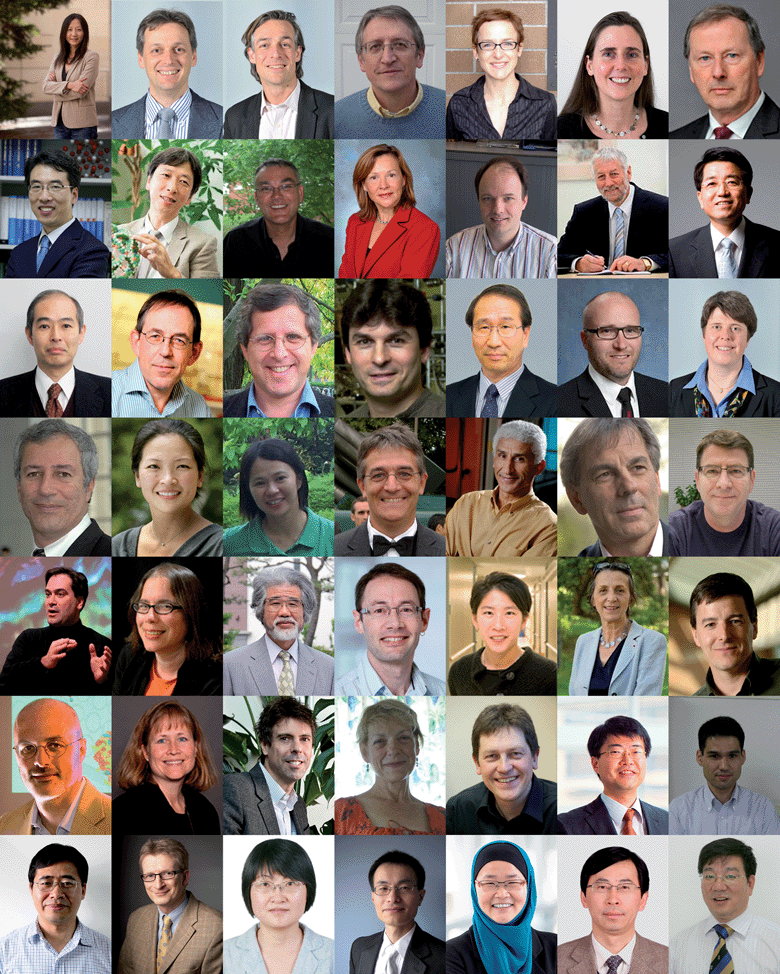 |
| | Fig. 1 Advisory Board members (from left to right, row 1: Zhenan Bao, Paul Blom, Mischa Bonn, Jean-Luc Brédas, Jillian Buriak, Rachel Caruso, Anthony Cheetham; row 2: Jinwoo Cheon, Makoto Fujita, David Haddleton, Naomi Halas, Jurriaan Huskens, Graham Hutchings, Taeghwan Hyeon; row 3: Hiroshi Imahori, René Janssen, Antoine Kahn, Ric Kaner, Susumu Kitagawa, Frederik Krebs, Katharina Landfester; row 4: Nate Lewis, Lynn Yueh Lin Loo, Hong Yee Low, Richard Martel, Hedi Mattoussi, Bert Meijer, Phillip Messersmith; row 5: Chad Mirkin, Catherine Murphy, Norio Nakatsuji, Markus Niederberger, Teri Odom, Marie-Paule Pileni, John Rogers; row 6: Vincent Rotello, Christine Schmidt, Gregory Scholes, Nava Setter, Peter Skabara, Takao Someya, Kazuo Takimiya; row 7: Shu Wang, Ulrich Wiesner, Yi Xie, Peidong Yang, Jackie Ying, Shu-Hong Yu, Dongyuan Zhao. Not pictured: David Weitz). | |
|
| This journal is © The Royal Society of Chemistry 2014 |
Click here to see how this site uses Cookies. View our privacy policy here. 
